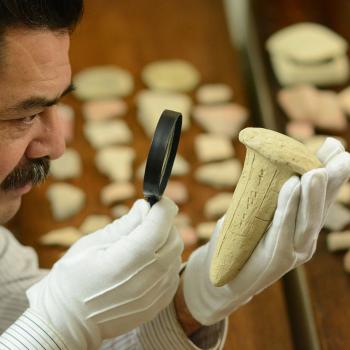
This entry focuses on the importance of learning to let it go and not fixate on the fruit of one’s action in life. If you are anything like me, it will take a lifetime to learn the fine art of renunciation.
Elsa learns to let it go.
My granddaughter Jaylah tells me with a cheeky smile on her face that I am a “horrible Elsa singer.” She loves to sing “Let It Go” from Frozen with her karaoke microphone system. But she stops me right away when I try to join in. Since she controls the microphone, I have to “let it go,” so to speak. Jaylah and I will simply have to beg to differ as we banter away on the quality of my Elsa impersonations. That said, I think she is on to something with me: I am horrible at “letting go” of fixating on the fruit of my action. How about you?
In the song “Let It Go,” Elsa determines that she will not allow others’ opinions enslave her. She comes to accept what makes her unique and not allow others’ views of her and their ideals of perfection to imprison her. It is little wonder that this song has become an anthem for different groups, including those in the disability community.
Learning to “let it go” in life is very important if we wish to be sane and well-balanced emotionally and spiritually. I have begun working on a book on various “world religions” and was struck by reading The Bhagavad Gita. Its predominant teaching of renunciation stood out most to me. Please allow me to engage this material to set the stage for my own reflections on my personal struggle with renunciation, that is, learning to “let it go” in life.
Krishna teaches Arjuna to let it go.
In the Gita, the Hindu deity Krishna instructs the great though reluctant warrior Arjuna on renunciation: “The poets know that the leaving aside of action based on desire is renunciation; and the clear-sighted see that the giving up of all fruit of such action is called letting go.” The Bhagavad Gita, Penguin Classics, translated by Laurie L. Patton (London: Penguin Books, 2008), 18.2, page 184 (italics added).
Krishna goes on to distinguish between various kinds of renunciation. One should not renounce prescribed action, which would not be fitting, leading only to confusion. Such problematic renunciation is deemed “tamasic” (18.7, page 186; it is “associated with negative behavior,” such as “greed, laziness, and dishonesty;” “Introduction” to Penguin Classics edition, page xix).
Neither should one let go of an action because it proves difficult, or out of fear of pain. This form of letting go or renunciation is also problematic. Krishna considers it “rajasic” (Gita, 18.8, page 186; it entails being given to passionate upheaval and heaviness; “Introduction” to Penguin Classics edition, page xix).
The kind of renunciation Krishna exhorts Arjuna to esteem is to “let go of clinging to the fruit” (Gita, 18.9, Penguin Classics, page 186; italics added). Krishna views such renunciation as “sattvic” (Gita, 18.9, page 186; it entails being “filled with light” and pertains to “honest and pure moral conduct;” “Introduction” to Penguin Classics edition, page xix).
Learning to “let it go” is far more difficult than one thinks.
“Letting go,” as in “renunciation,” is not as easy as it sounds. Krishna’s intricate instruction to Arjuna impresses upon me that renunciation is like a fine art. It also calls to mind Gurcharan Das’s masterful work on The Mahābhārata titled, The Difficulty of Being Good: On the Subtle Art of Dharma (Oxford: Oxford University Press, 2009). A consumer culture mindset that desires quick fix solutions and instant gratification will never experience mastery of such fine, subtle art forms. Learning to “let it go” requires great wisdom, patience, a delicate balance involving attention to nuance and complexity, and pain-staking action.
Don’t approve of every form of “let it go.”
Krishna esteems renunciation at various points in the Gita, but not every kind of renunciation. The introduction to the Penguin Classics edition puts it this way: “the Gita is not criticizing non-action, or renunciation, as a way of life…, the text is arguing that it is illusory to assume that non-action, or renunciation, is the solution to the dilemmas that face us…, the Gita is saying that action without insight, and action while clinging to the fruits, leads us astray” (Introduction to Penguin Classics edition, xx-xxi).
Krishna exhorts Arjuna to engage in the prescribed action of combat in an impending war that is his lot as a supreme warrior. He is to do so in a fitting manner. That is, Arjuna must renounce “clinging to the fruits” of his action (The Mahābhārata chronicles this war at great length).
Gandhi encourages us to let it go.
Mahatma Gandhi interprets the warfare that Arjuna engages in allegorically. For Gandhi, it is spiritual rather than physical in nature. Gandhi sees renunciation or non-attachment as the central teaching of the Gita. Here is how he conceives the favored form of renunciation, according to one source:
“Anasakti” or non-attachment to the fruits of one’s actions is the principal message of the Gita. The idea of karma-falatyaga (karma: action; fala: fruit, and tyaga: renouncement) is also conveyed by another Sanskrit term: nish-kama karma (nish: non; kama: desire, and karma: action). This principle of renunciation of the desire for the fruits of action recurs like a refrain throughout the Gita; it is particularly emphasized in Sankhya Yoga (Ch. 2, v. 47): “karmanye vadhikaraste ma phaleshu kadachana: your business is with the action only, never with its fruits;” in Karma Yoga (Ch. 3, v. 19): “tasmat asaktaha satatam karyam karma samachar: therefore, perform action constantly without attachment”; in the Jnanavibhaga Yoga (Ch. 4, v. 20): “tyaktva karmaphalasangam: abandon attachment to the fruit of action”; and in the Bhakti Yoga (Ch. 12, v. 11): “sarvakarma-phala-tyagam tatah kuru yatatmavan: renounce therefore all fruit of action with self control.”
For Gandhi, we should not be indifferent to the results of our action. We should seek to perfect our actions, but not fixate or fret over the results:
“In no way it means indifference to result,” clarifies Gandhi and explains, “Renunciation means absence of hankering after fruit, because attachment, worry, haste affect our nervous system and upset the balance of our mind” (Anasaktiyoga, 7). It is not unnatural to feel happy about the good outcome of one’s hard work, but it is wasteful, both spiritually and psychologically, to invest all one’s emotions and energy in fretting over the results instead of focusing on perfecting the work.”
Gandhi points out how Krishna and Jesus instruct us to let it go.
Gandhi marveled over what he saw as parallels between Krishna’s view of renunciation in the Gita and Jesus in the Sermon on the Mount. The italicized teaching contained in the following pericope in the Sermon on the Mount spoke deeply to Gandhi:
“You have heard that it was said, ‘Eye for eye, and tooth for tooth.’ But I tell you, do not resist an evil person. If anyone slaps you on the right cheek, turn to them the other cheek also. And if anyone wants to sue you and take your shirt, hand over your coat as well. If anyone forces you to go one mile, go with them two miles. Give to the one who asks you, and do not turn away from the one who wants to borrow from you.” (Matthew 5:38-42; NIV)
Gandhi confessed that Jesus’ teaching on renunciation “delighted” him “beyond measure.” For Gandhi, this theme that he found in the Gita, the Sermon on the Mount, and The Light of Asia spoke deeply to him. He came away from his reflections to declare that “renunciation was the highest form of religion” (Mohandas K Gandhi, The Story of My Experiments with Truth, with a foreword by Sissela Bok (Boston: Beacon Press, 1993), 68-69.
I need to learn to let it go.
Now I will return to my own personal struggle with “let it go,” or renunciation. I cannot control how others will respond to me. I can only control how I will engage in carrying out actions which are appropriate to my calling in life as a husband, father, grandfather, friend, professor, pastor, writer, etc. Certainly, I can seek to improve my care for others. I can certainly seek to perfect my teaching, pastoring, and writing. But I must not put the emphasis on how others will respond or let their opinions of me or my work enslave me.
I need to let go and let God take care of the breadth.
I like how my pastoral counselor Tom Schiave puts it in talking about one’s ministry: “Take care of the depth. Let God take care of the breadth.” Jesus puts it this way in the Sermon on the Mount:
And why do you worry about clothes? See how the flowers of the field grow. They do not labor or spin. Yet I tell you that not even Solomon in all his splendor was dressed like one of these. If that is how God clothes the grass of the field, which is here today and tomorrow is thrown into the fire, will he not much more clothe you—you of little faith? So do not worry, saying, ‘What shall we eat?’ or ‘What shall we drink?’ or ‘What shall we wear?’ For the pagans run after all these things, and your heavenly Father knows that you need them. But seek first his kingdom and his righteousness, and all these things will be given to you as well. Therefore do not worry about tomorrow, for tomorrow will worry about itself. Each day has enough trouble of its own. (Matthew 6:28-34; NIV)
Why do I worry rather than let it go?
Why do I worry about how well I sing “Let It Go”? Ala, no matter how well I sing it, I will never win my witty, ever-bantering granddaughter’s approval?! Why do I worry about what I will wear or eat or wear, or about gaining a fitting response that reflects what I take to be proper care for others? Why worry about the breadth of my ministry’s impact? And why do I worry so often about letting it all go?!
I have enough on my plate in simply trying to care to the best of my ability and in a thoughtful way for my granddaughter and others entrusted to my care. Surely, I have enough to focus on in seeking first God’s kingdom and his righteousness. I need to let it go and let God give me what I need to carry out the Lord’s will for my life. Above all, I need to focus on going deeper and letting God take care of increasing the breadth of my life’s work for Jesus’ sake.
It will take a lifetime to let it go and master the fine art of renunciation. But it will be worth the effort for you and me.
If you are anything like me, you struggle to let it go. In fact, it will take us a lifetime to learn to let it go and renounce fixating on the fruit of our action. But it will be worth it. To master this fine art of renunciation, we will need to make sure we are focusing on doing what we are called to do, not on others’ opinions and approval. We cannot really care appropriately for them when their anticipated response controls our aims and actions. Constructive criticism that helps us improve appropriate care certainly has its place. But if others seek to force us to fit into their envisioned mold for our lives, we are doing no one any service.
Elsa had to learn to let it go as a queen and make the most of her unique gifting in life. Arjuna had to renounce or let go of fixating on the fruit of his action and do what was required of him as a warrior. You and I need to sing and fight and do everything in our power in “a clear-sighted way” to seek first God’s kingdom in caring sacrificially for others. Let it go.














